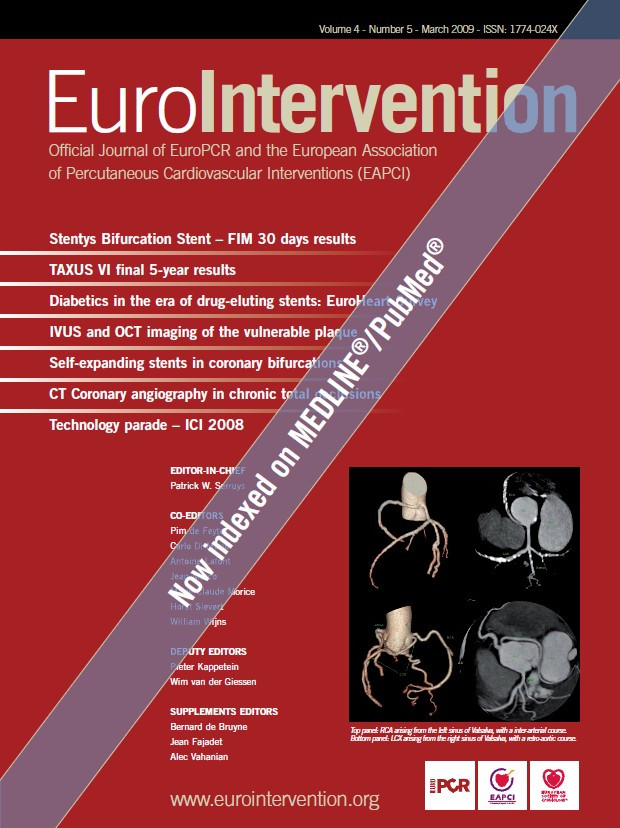Dear Colleagues,
This issue delights us in the way it mirrors the multifaceted interests of our specialty, touching on aspects ranging from original research to long-term trials and studies. Our ever expanding technologies, our Europe-driven, but international participation, all these many directions find their place in this current issue of EuroIntervention. Our audience is global, our interests remain vast, and our authors and Editorial Board reflect and are dedicated to these many tendencies and traditions.
The heart of the matter
We begin with continuity. Within these pages, you will find the much awaited five year results of Taxus VI, presented by Eberhard Grube et al assessing “the long-term safety and efficacy of the paclitaxel-eluting TAXUS moderate-release (MR) investigation-only stent” used here for “the treatment of long, complex coronary artery lesions.”
Innovation and research have their place here as well, and Stefan Verheye et al’s first-in-man (FIM) study is clearly in this category presenting a “provisional, self-expanding drug eluting or bare metal stent” for use in bifurcations: this is “the acute and 30 day results of the OPEN I study evaluating the new Stentys™ bifurcation stent.” Hasan Jilaihawi et al reviews a number of novel self-expanding stents and their use in bifurcations.
In this issue of EuroIntervention Carlo di Mario comments on the paper “Computed Tomography in Total Coronary Occlusion (CTTO Registry): radiation exposure and predictors of successful percutaneous intervention” from Héctor M. García-García et al. From a slightly different perspective within the CTO debate, Ioannis Paizis et al highlights “Percutaneous coronary intervention for chronic total occlusions: the role of side-branch obstruction”. You will discover clinical research papers on imaging, there is one from Boston, MA, USA by Adrian F. Low et al on “In vivo characterisation of coronary plaques with conventional grey-scale intravascular ultrasound: correlation with optical coherence tomography”. Oscar Semeraro et al re-examines “minimal luminal diameter relocation and quantitative coronary angiography – intravascular ultrasound correlations in stented saphenous vein grafts: methodological insights from the randomised RRISC trial”. There is “Prevalence and characteristics of major and minor coronary artery anomalies in an adult population assessed by computed tomography coronary angiography” by Gastón A. Rodríguez-Granillo and colleagues while Ariel Roguin et al gives us a “Novel method for real-time hybrid cardiac CT and coronary angiography image registration: visualising beyond luminology”.
This last paper mentioned above is from Israel where –also in this issue– you will find a special section highlighting the “Parade of Technology” from the “Innovations in Cardiovascular Interventions” (ICI) meeting held last December 2008 in Tel Aviv. ICI has become an important “showcase” for emerging as well as proven technologies and we have the opportunity of seeing what was so recently presented, selected for us by Raphael Beyar and Chaim Lotan.
European roots
This journal is European, and one look at the appendix of the article “Interventional treatment in diabetics in the era of drug eluting stents and compliance to the ESC guidelines: lessons learned from the Euro Heart Survey Programme” by Yoshinobu Onuma et al clearly underlines the enormous European-wide effort, collaboration and organisation that this undertaking represents. Besides the country-by-country participation for the study as a whole, the percutaneous coronary intervention expert committee itself was chaired by Jean Marco with Anselm K. Gitt, Uwe Zeymer and Sigmund Silber from Germany; Alec Vahanian from France; Franz Weidinger from Austria; William Wijns, Belgium; myself from The Netherlands; Ricardo Seabra-Gomez, Portugal and Franz Eberli from Switzerland.
It has long been known to us that diabetic patients face “an aggressive form of atherosclerosis” less favourable to long-term survival after (PCI), especially when compared to patients without diabetes. With the prevalence of diabetes, both diagnosed and undiagnosed increasingly high, it was important to focus the European Heart Survey (EHS) Programme’s most recent survey performed in 2005-2006, concentrating on the PCI registry database to “determine the demographics and the in-hospital outcome of diabetic and non-diabetic patients treated with PCI in Europe; report the type of equipment and technology used for PCI procedures in diabetics and clarify whether the treatment of diabetic patients complies to current European Society of Cardiology (ESC) guidelines.” Clearly essential reading for us all.
This then is our current journal, many topics, multiple points-of-view, and like the rest of our work at EuroIntervention when taken as a whole, our contribution to the active and constructive dialogue that is our profession today.
We hope you will enjoy this issue, and we look forward to hearing from you soon.

